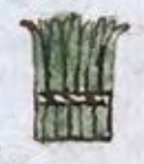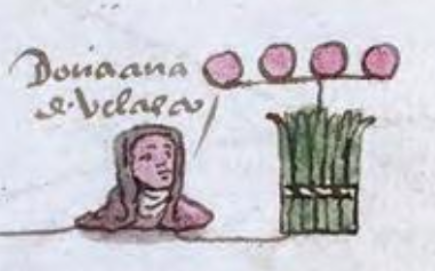mazatlacualli (Osu15r)
This name for this simplex glyph comes from the Codex Osuna, even though this particular example is not glossed as such. It is also called “zacate” (the Hispanized form of zacatl). Rather, this glyph is discussed in a Spanish text as “yerba” (hierba) for feeding horses. It is a green, upright bundle of grass with a white cord that ties it together about two-thirds of the way down from the pointed tops.
Stephanie Wood
In the contextualizing image for this glyph, one also sees the head of the viceroy’s daughter, doña Ana de Velasco, in a frontal view. She wears a brown head covering and a white blouse with a cowl neck. The local Nahuas have been asked to provide her with five bundles of grass for her horses. A notation of four bundles consists of four small circles painted red, connected to one another with a line, plus another line connecting them to the grass bundle. A fifth bundle appears between Ana and her father, don Luis de Velasco, the viceroy. He got one hundred twenty bundles.
Stephanie Wood
1551–1565
Jeff Haskett-Wood
venados, caballos, comida, paja, hierba, forraje, heno, zacate

mazatlacual(li), grass or hay, forage for feeding horses, https://nahuatl.wired-humanities.org/content/mazatlacualli
la hierba or paja (para dar a comer a los caballos)
Stephanie Wood
Library of Congress Online Catalog and the World Digital Library, Osuna Codex, or Painting of the Governor, Mayors, and Rulers of Mexico (Pintura del Gobernador, Alcaldes y Regidores de México), https://www.loc.gov/resource/gdcwdl.wdl_07324/. The original is located in the Biblioteca Nacional de España.
"The Library of Congress is unaware of any copyright or other restrictions in the World Digital Library Collection. Absent any such restrictions, these materials are free to use and reuse." But please cite the Biblioteca Nacional de España and this Visual Lexicon of Aztec Hieroglyphs if you use any of these images here or refer to the content on this page, providing the URL.





